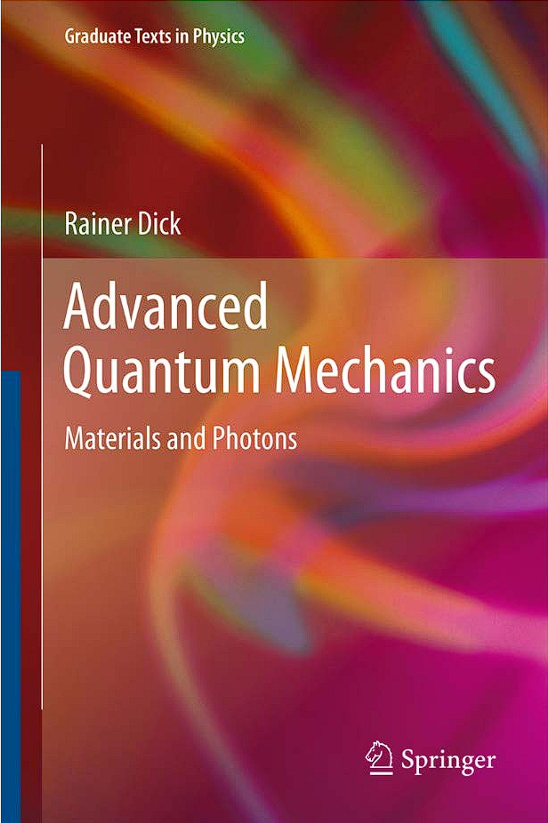
Advanced Quantum Mechanics Materials and Photons
Author: Rainer Dick Category: Mekanika Kuantum Publisher: Springer ISBN: 978-1-4419-8076-2 Quantum mechanics was invented in an era of intense and seminal scientific re
search between 1900 and 1928 (and in many regards continues to be developed
and expanded) because neither the properties of atoms and electrons, nor the
spectrum of radiation from heat sources could be explained by the classical
theories of mechanics, electrodynamics and thermodynamics. It was a major
intellectual achievement and a breakthrough of curiosity driven fundamental
research which formed quantum theory into one of the pillars of our present
understanding of the fundamental laws of nature. The properties and behav
ior of every elementary particle is governed by the laws of quantum theory.
However, the rule of quantum mechanics is not limited to atomic and sub
atomic scales, but also affects macroscopic systems in a direct and profound
manner. The electric and thermal conductivity properties of materials are de
termined by quantum effects, and the electromagnetic spectrum emitted by a
star is primarily determined by the quantum properties of photons. It is there
fore not surprising that quantum mechanics permeates all areas of research
in advanced modern physics and materials science, and training in quantum
mechanics plays a prominent role in the curriculum of every major physics or
chemistry department.
The ubiquity of quantum effects in materials implies that quantum mechanics
also evolved into a major tool for advanced technological research. The con
struction of the first nuclear reactor in Chicago in 1942 and the development of
nuclear technology could not have happened without a proper understanding of
the quantum properties of particles and nuclei. However, the real breakthrough
for a wide recognition of the relevance of quantum effects in technology occured
with the invention of the transistor in 1948 and the ensuing rapid development
of semiconductor electronics. This proved once and for all the importance of
quantum mechanics for the applied sciences and engineering, only 22 years
after publication of the Schr¨odinger equation! Electronic devices like transis
tors rely heavily on the quantum mechanical emergence of energy bands in
materials, which can be considered as a consequence of combination of many
atomic orbitals or as a consequence of delocalized electron states probing a
lattice structure. Today the rapid developments of spintronics, photonics and
nanotechnology provide continuing testimony to the technological relevance of
quantum mechanics.
As a consequence, every physicist, chemist and electrical engineer nowadays
has to learn aspects of quantum mechanics, and we are witnessing a time
Preface
when also mechanical and aerospace engineers are advised to take at least a
2nd year course, due to the importance of quantum mechanics for elasticity and
stability properties of materials. Furthermore, quantum information appears to
become inceasingly relevant for computer science and information technology,
and a whole new area of quantum technology will likely follow in the wake
of this development. Therefore it seems safe to posit that within the next
two generations, 2nd and 3rd year quantum mechanics courses will become as
abundant and important in the curricula of science and engineering colleges as
f
irst and second year calculus courses.
Quantum mechanics continues to play a dominant role in particle physics and
atomic physics- after all, the Standard Model of particle physics is a quantum
theory, and the spectra and stability of atoms cannot be explained without
quantum mechanics. However, most scientists and engineers use quantum me
chanics in advanced materials research. Furthermore, the dominant interaction
mechanisms in materials (beyond the nuclear level) are electromagnetic, and
many experimental techniques in materials science are based on photon probes.
The introduction to quantum mechanics in the present book takes this into
account by including aspects of condensed matter theory and the theory of
photons at earlier stages and to a larger extent than other quantum mechanics
texts. Quantum properties of materials provide neat and very interesting il
lustrations of time-independent and time-dependent perturbation theory, and
many students are better motivated to master the concepts of quantum me
chanics when they are aware of the direct relevance for modern technology.
A focus on the quantum mechanics of photons and materials is also perfectly
suited to prepare students for future developments in quantum information
technology, where entanglement of photons or spins, decoherence, and time
evolution operators will be key concepts.
Other novel features of the discussion of quantum mechanics in this book
concern attention to relevant mathematical aspects which otherwise can only
be found in journal articles or mathematical monographs. Special appendices
include a mathematically rigorous discussion of the completeness of Sturm
Liouville eigenfunctions in one spatial dimension, an evaluation of the Baker
Campbell-Hausdorff formula to higher orders, and a discussion of logarithms of
matrices. Quantum mechanics has an extremely rich and beautiful mathemat
ical structure. The growing prominence of quantum mechanics in the applied
sciences and engineering has already reinvigorated increased research efforts
on its mathematical aspects. Both students who study quantum mechanics
for the sake of its numerous applications, as well as mathematically inclined
students with a primary interest in the formal structure of the theory should
therefore find this book interesting.
This book emerged from a quantum mechanics course which I had introduced
at the University of Saskatchewan in 2001. It should be suitable both for
advanced undergraduate and introductory graduate courses on the subject.
To make advanced quantum mechanics accessible to wider audiences which
might not have been exposed to standard second and third year courses on
atomic physics, analytical mechanics, and electrodynamics, important aspects
of these topics are briefly, but concisely introduced in special chapters and
appendices. The success and relevance of quantum mechanics has reached far
beyond the realms of physics research, and physicists have a duty to dissemi
nate the knowledge of quantum mechanics as widely as possible
Back